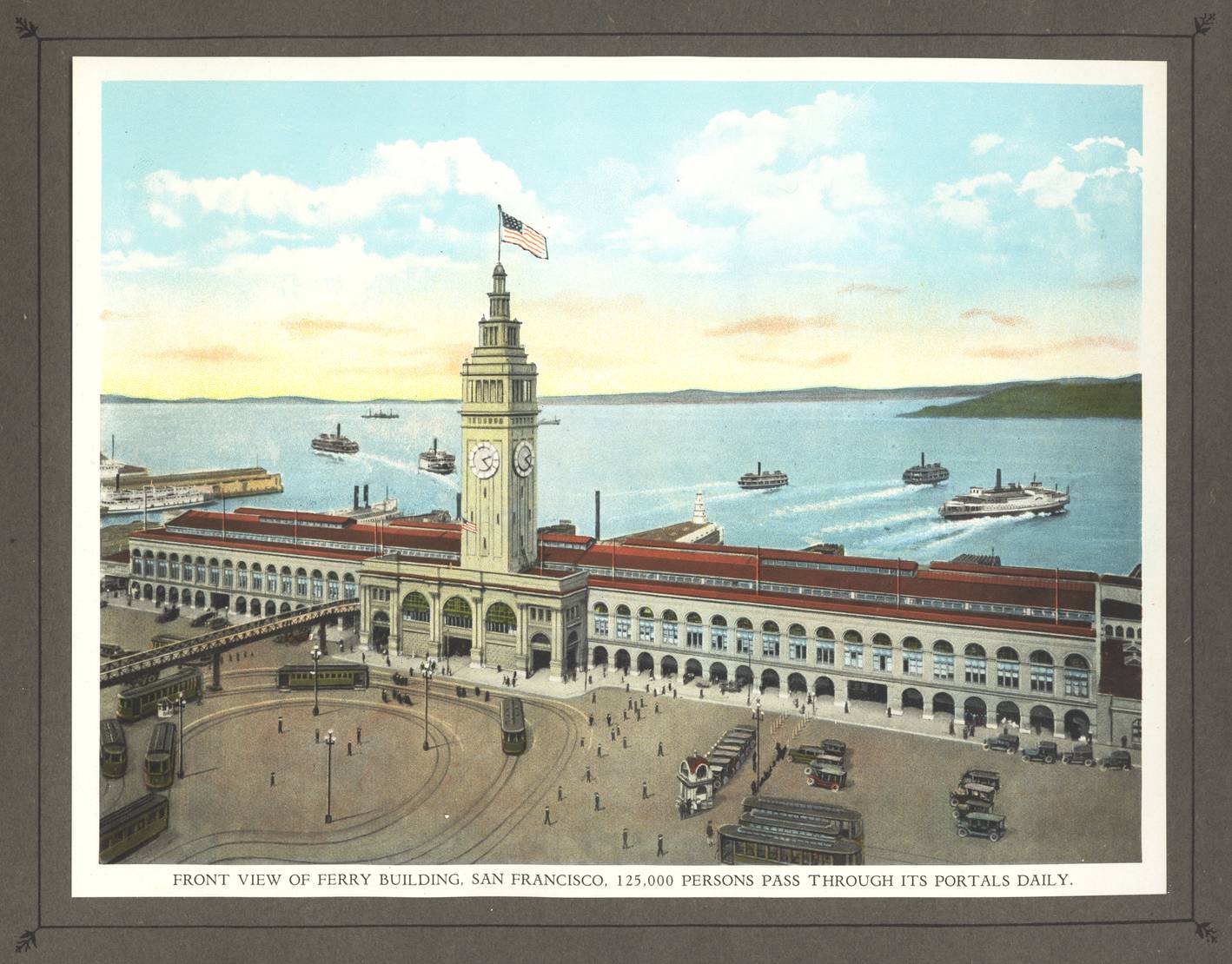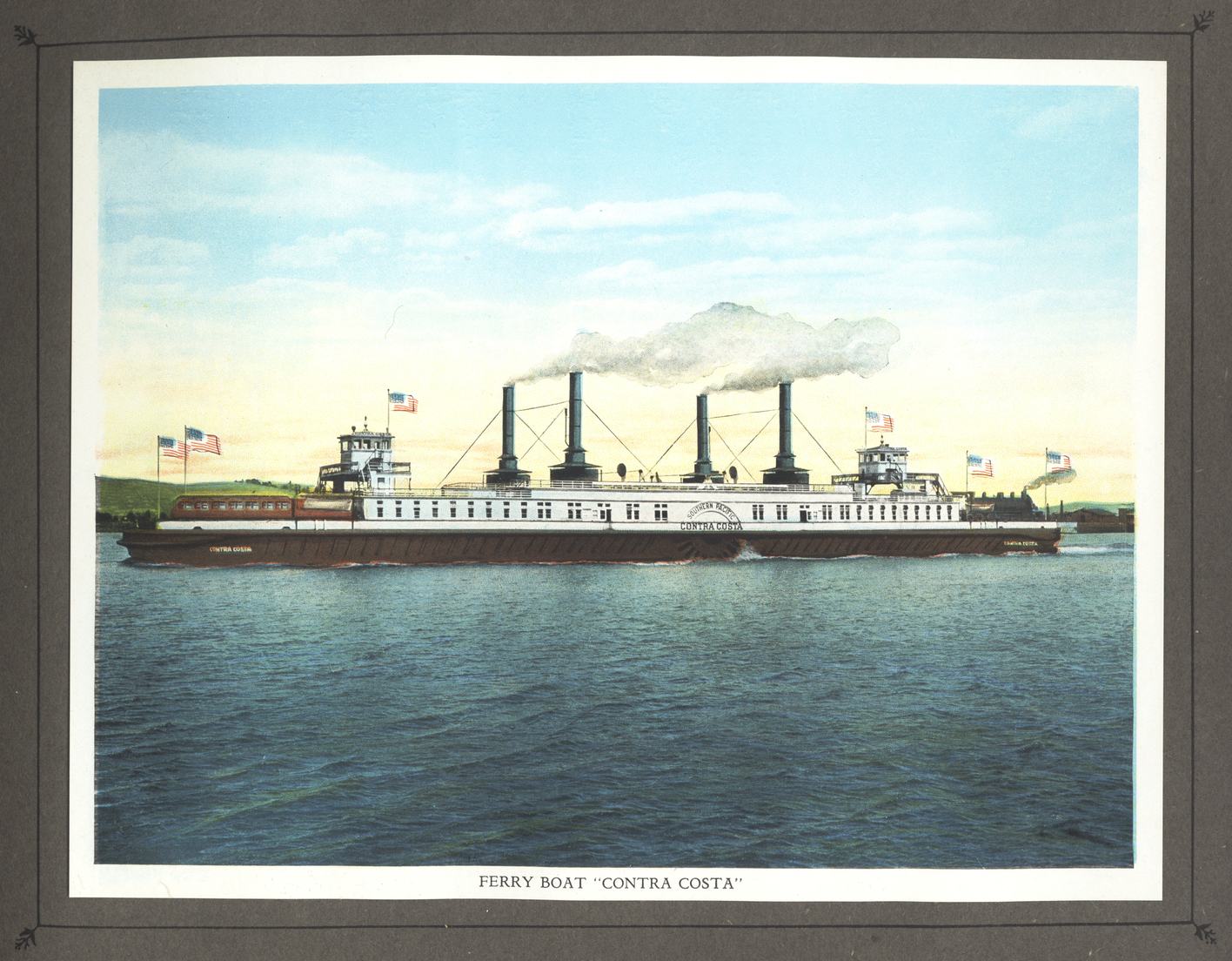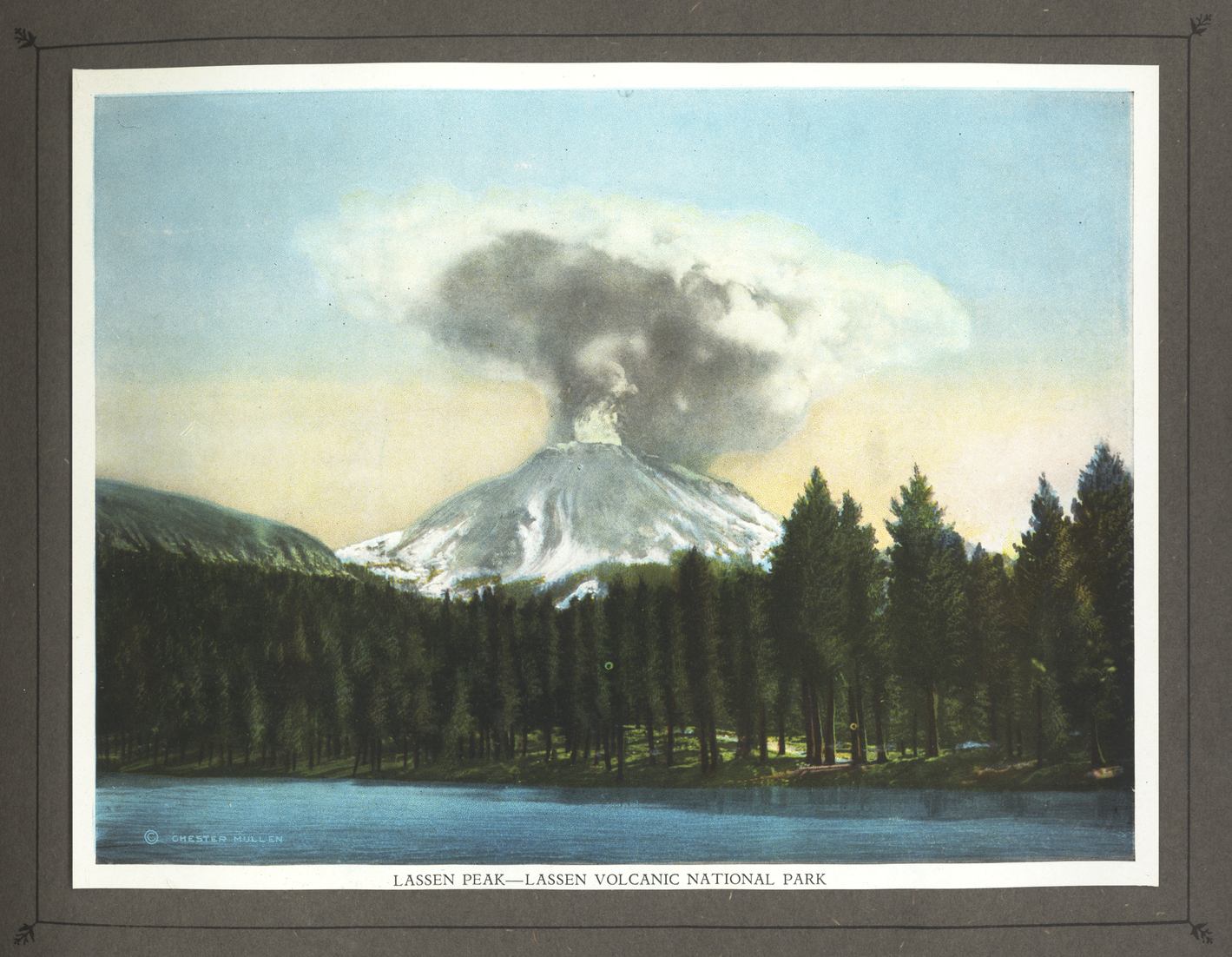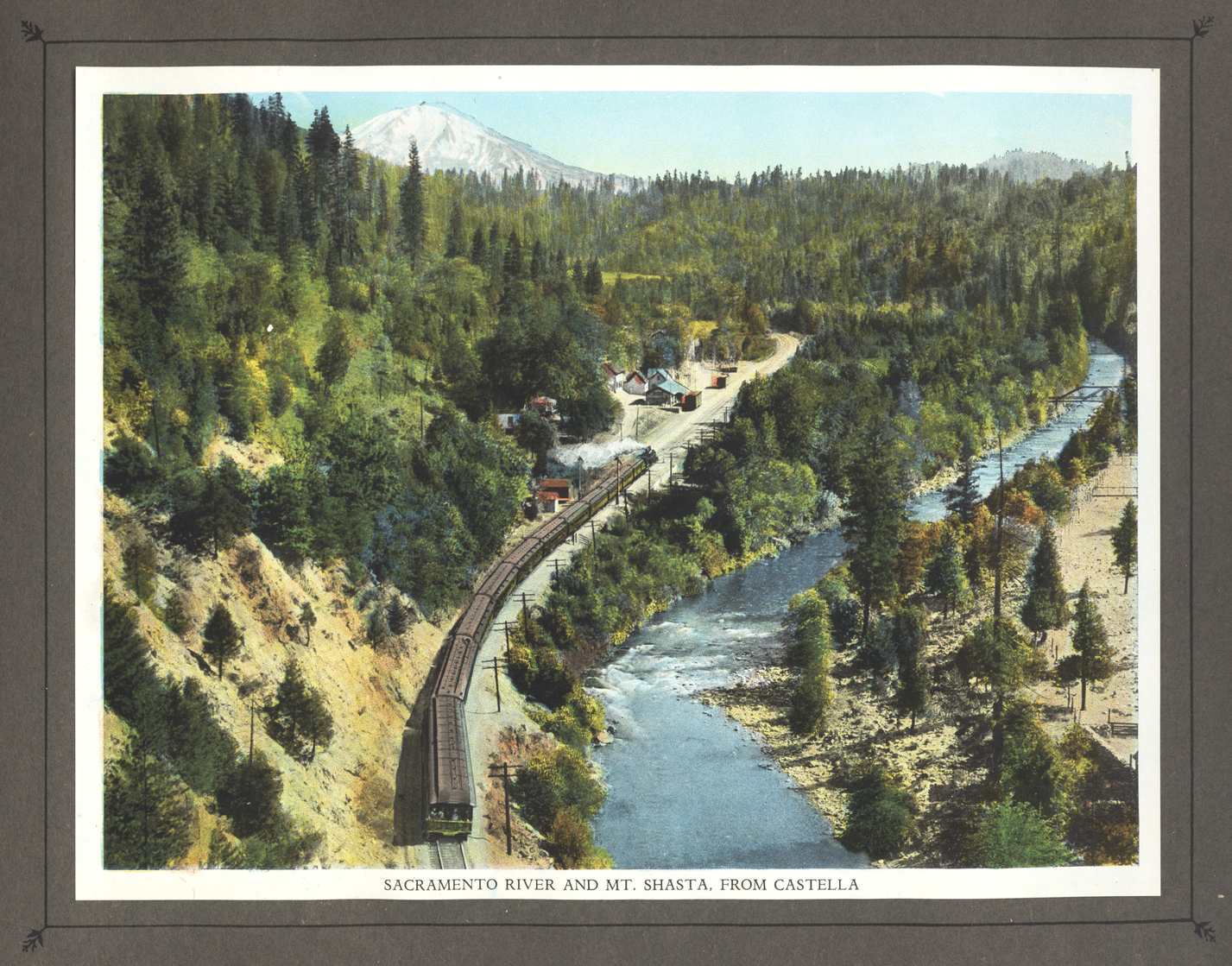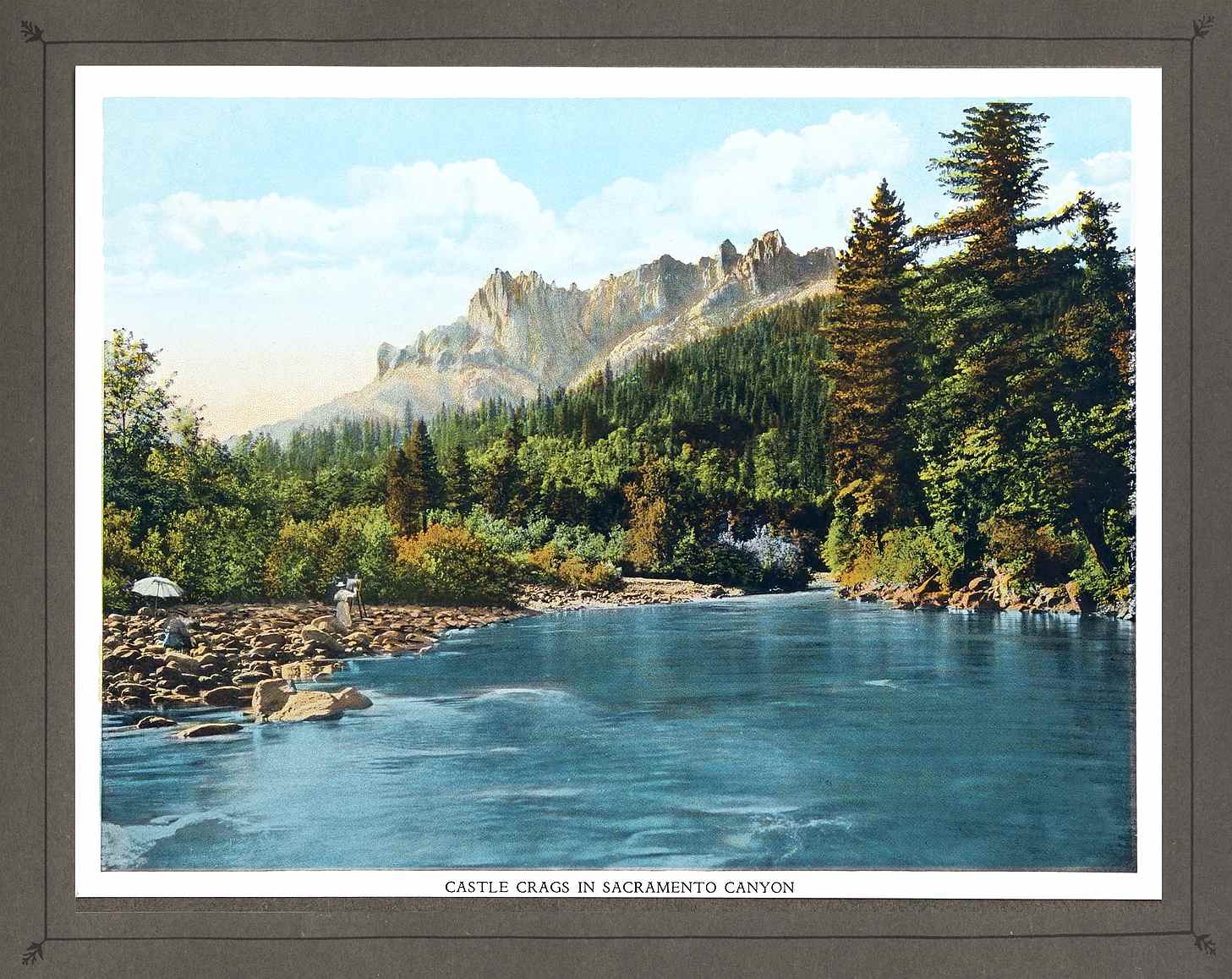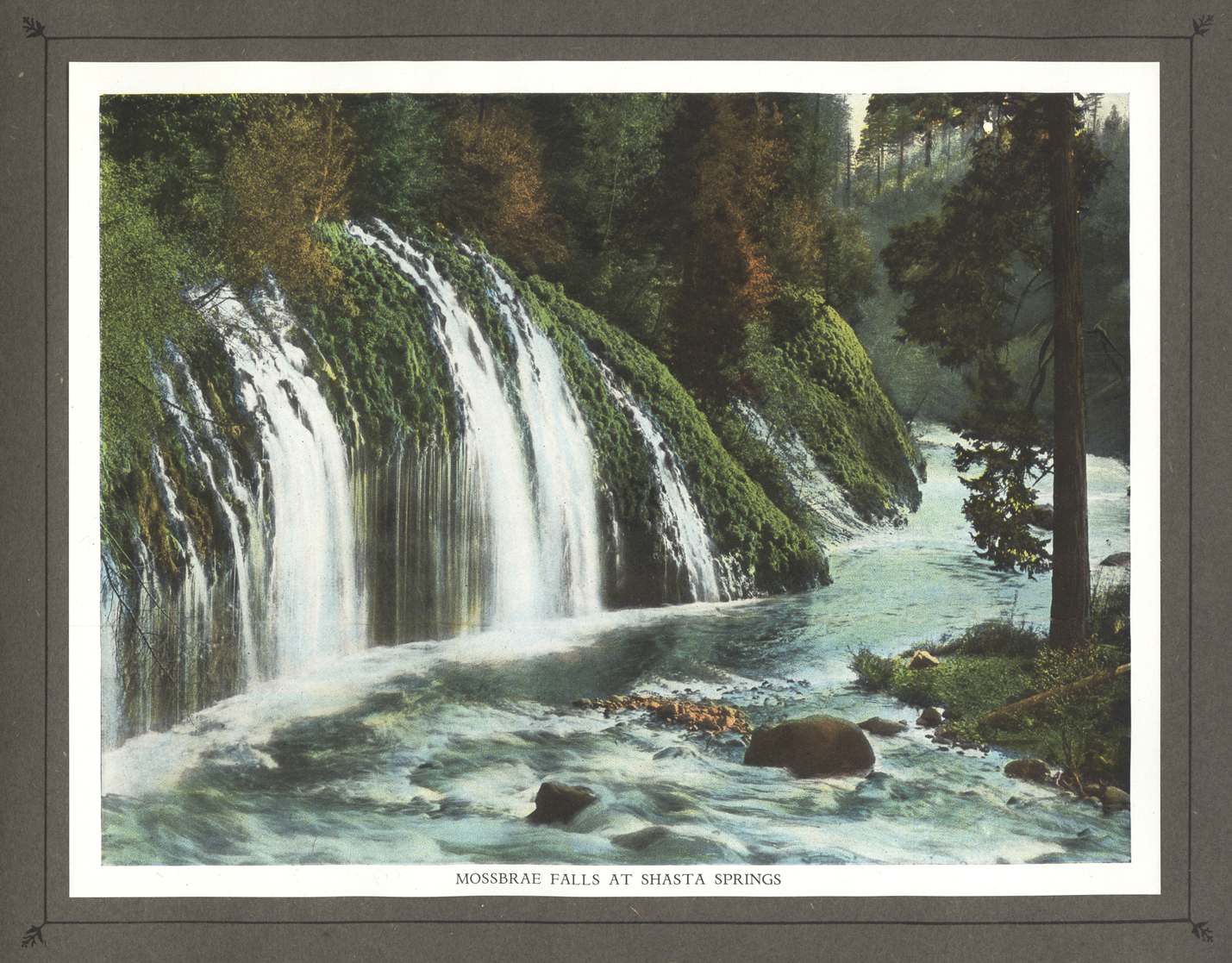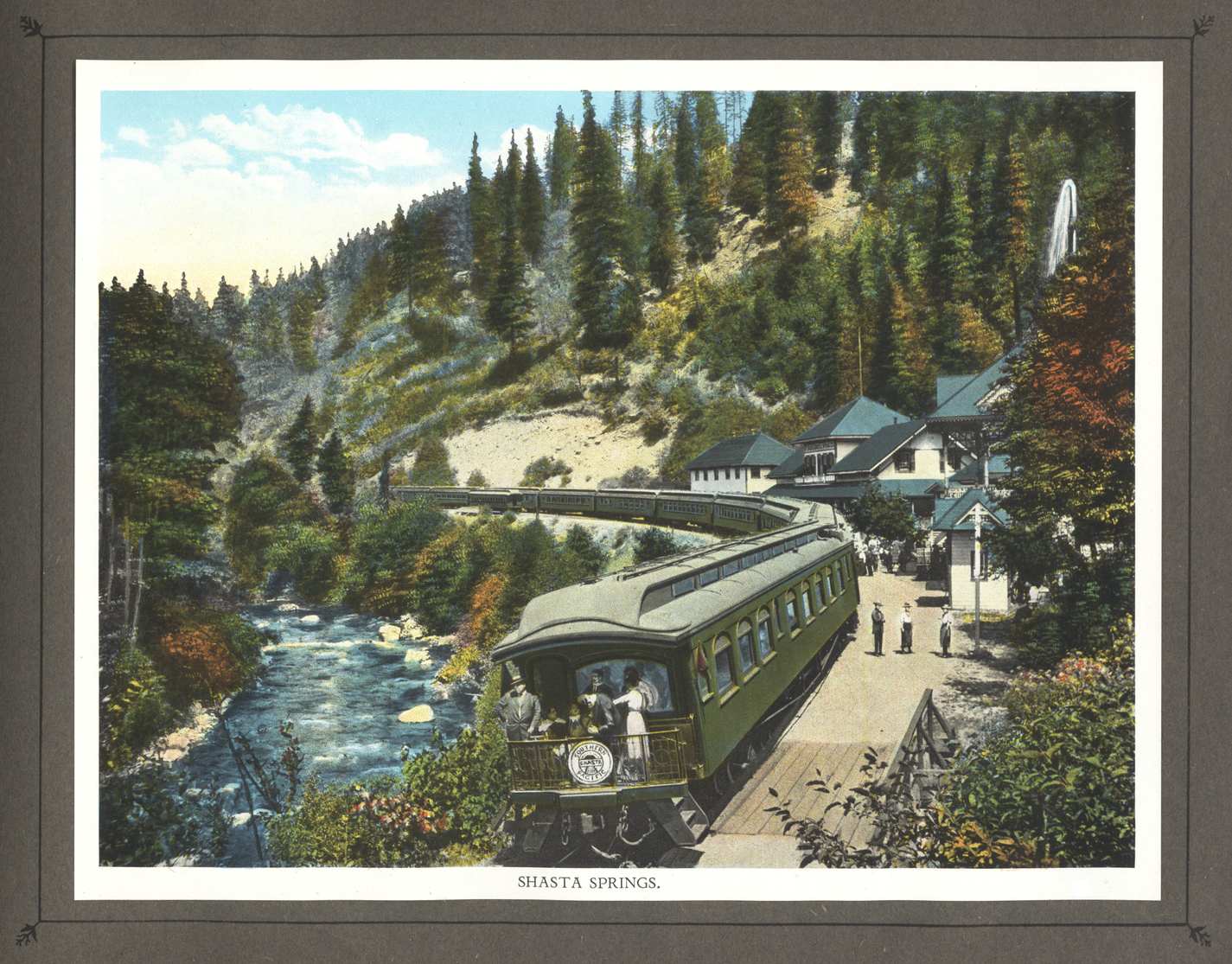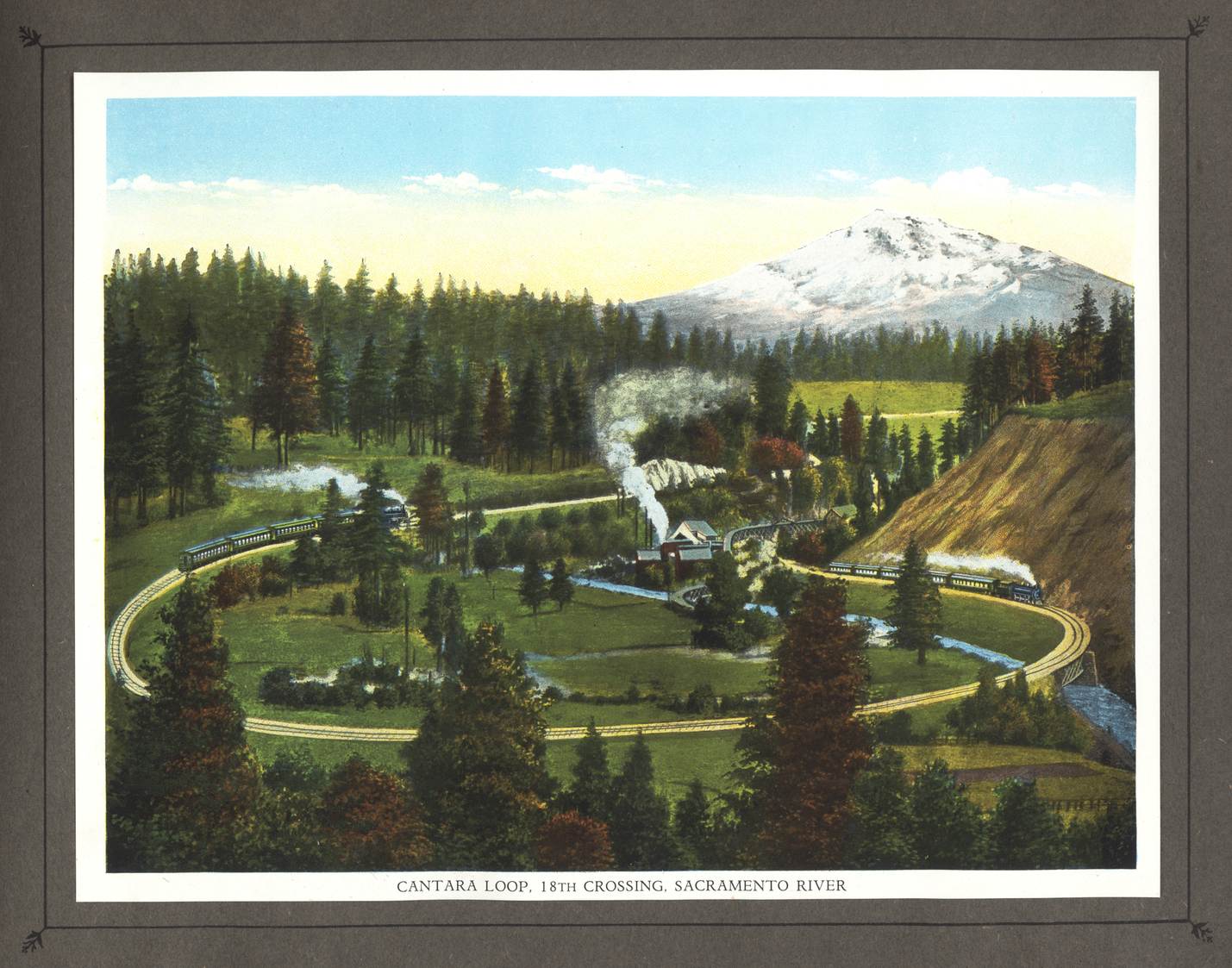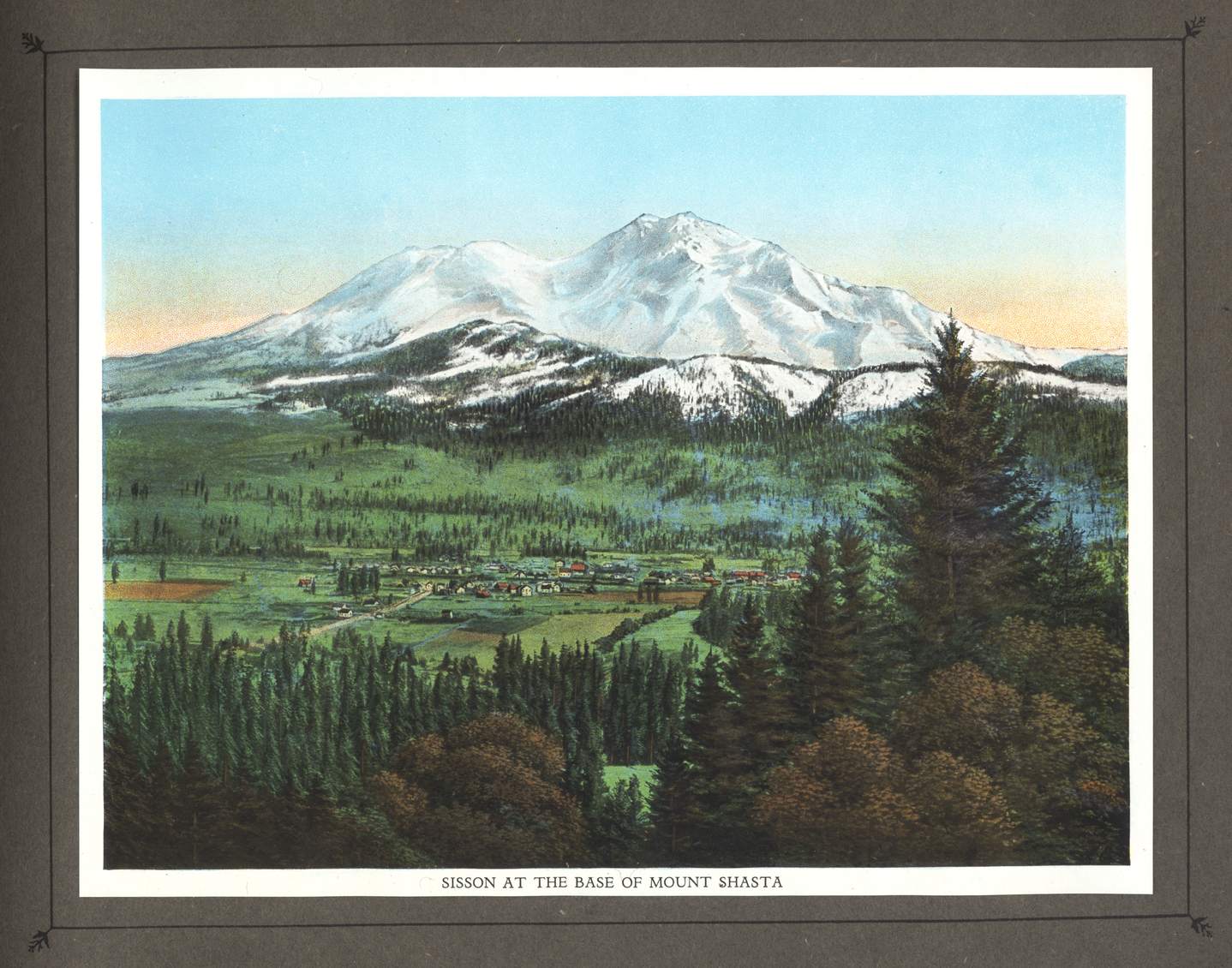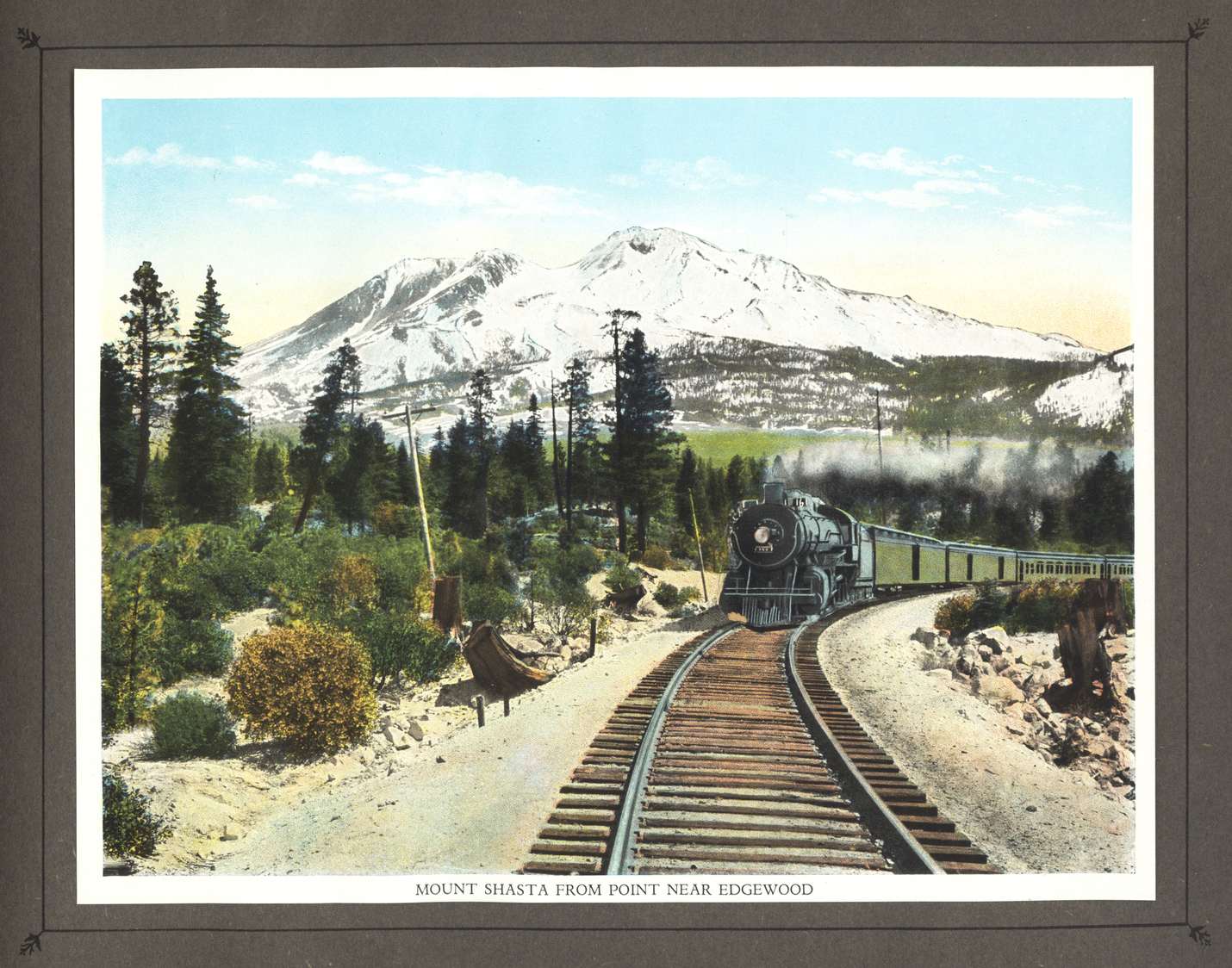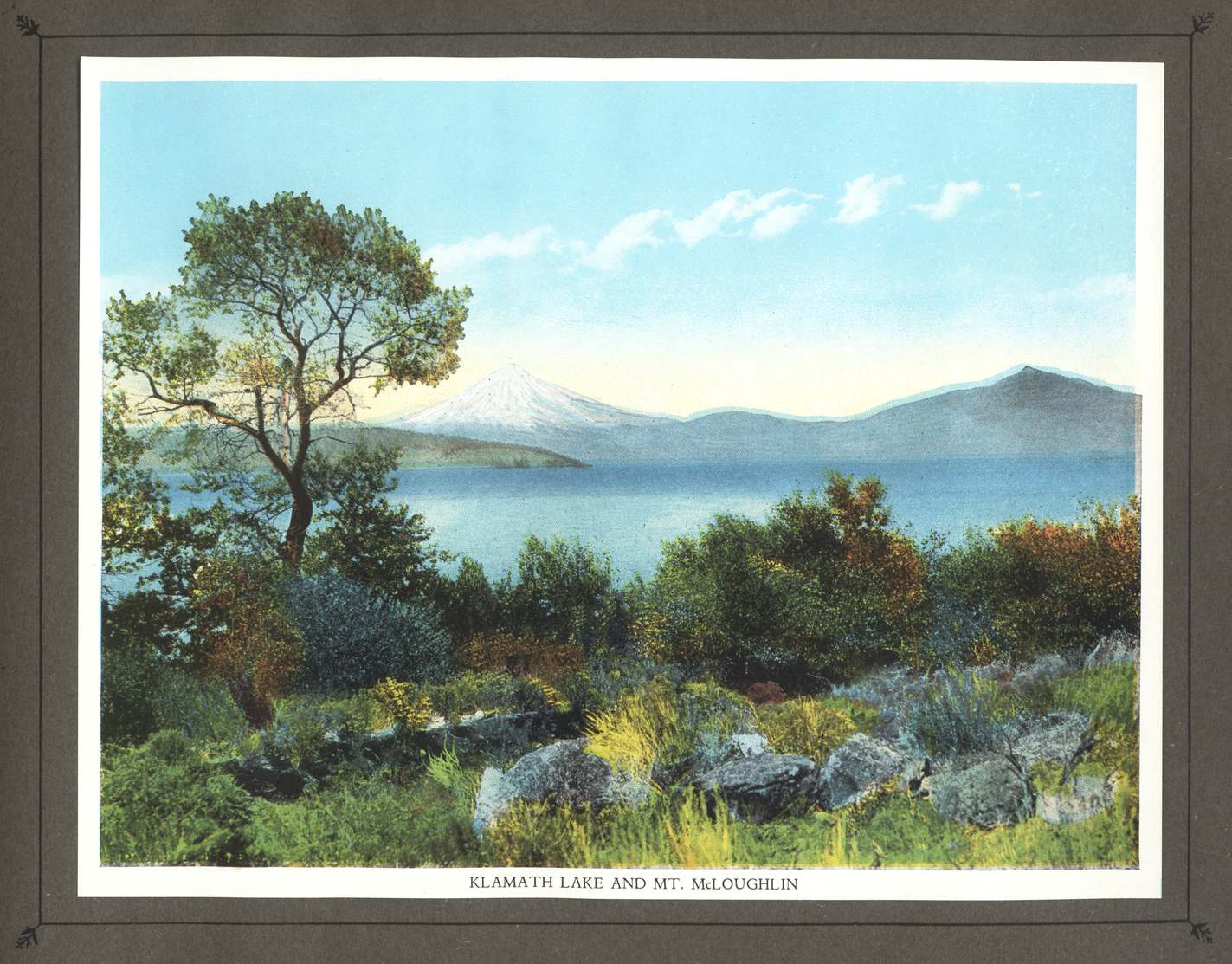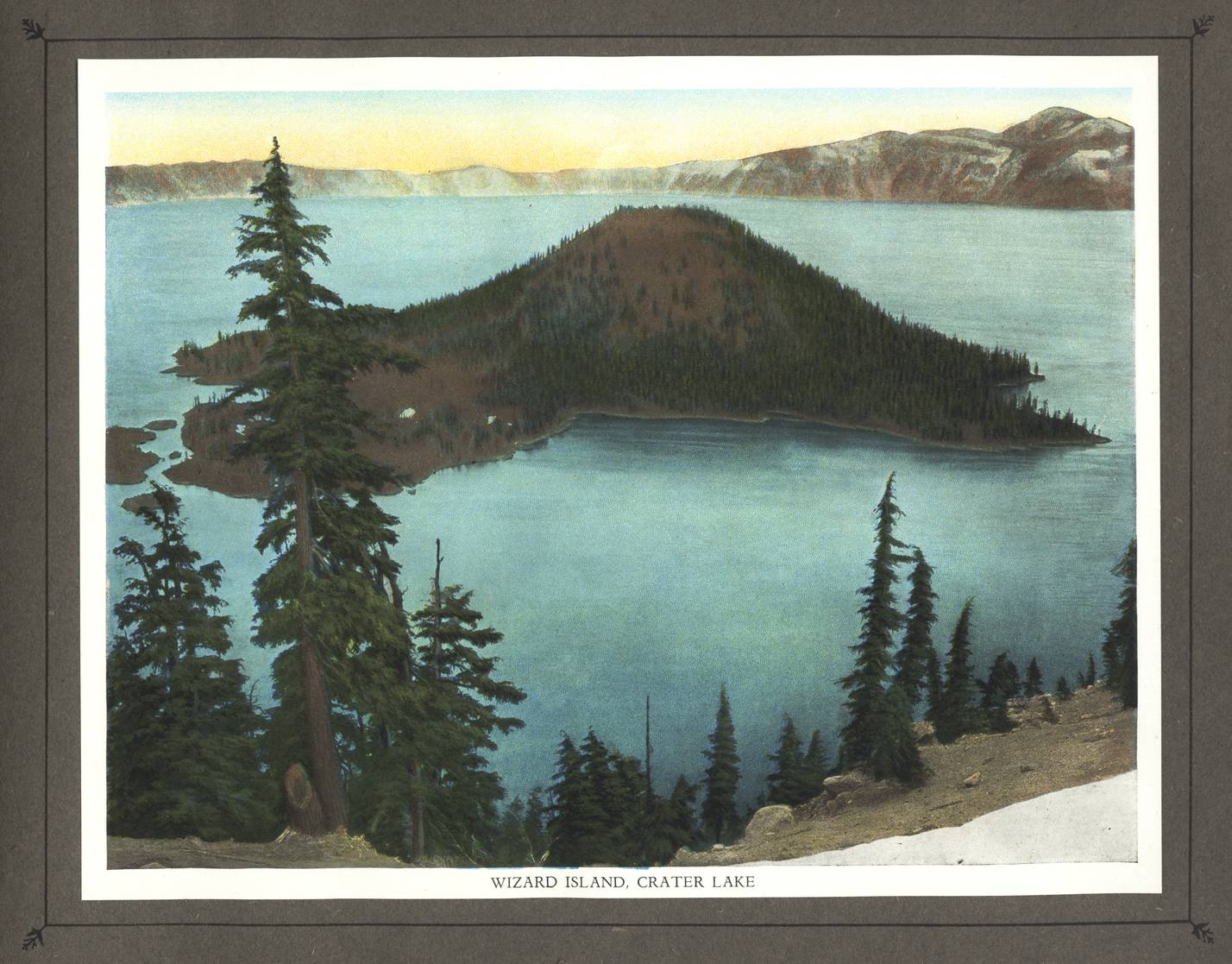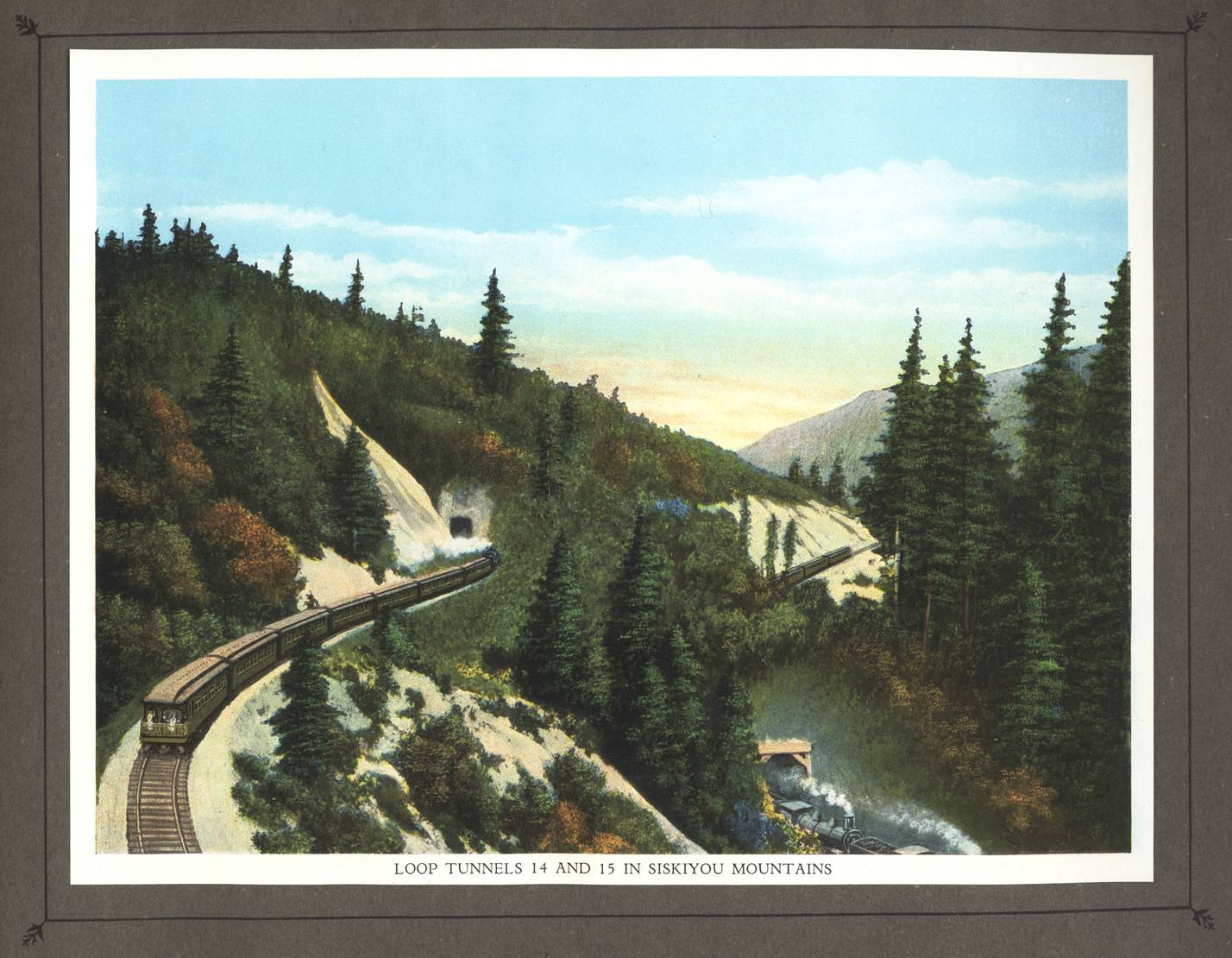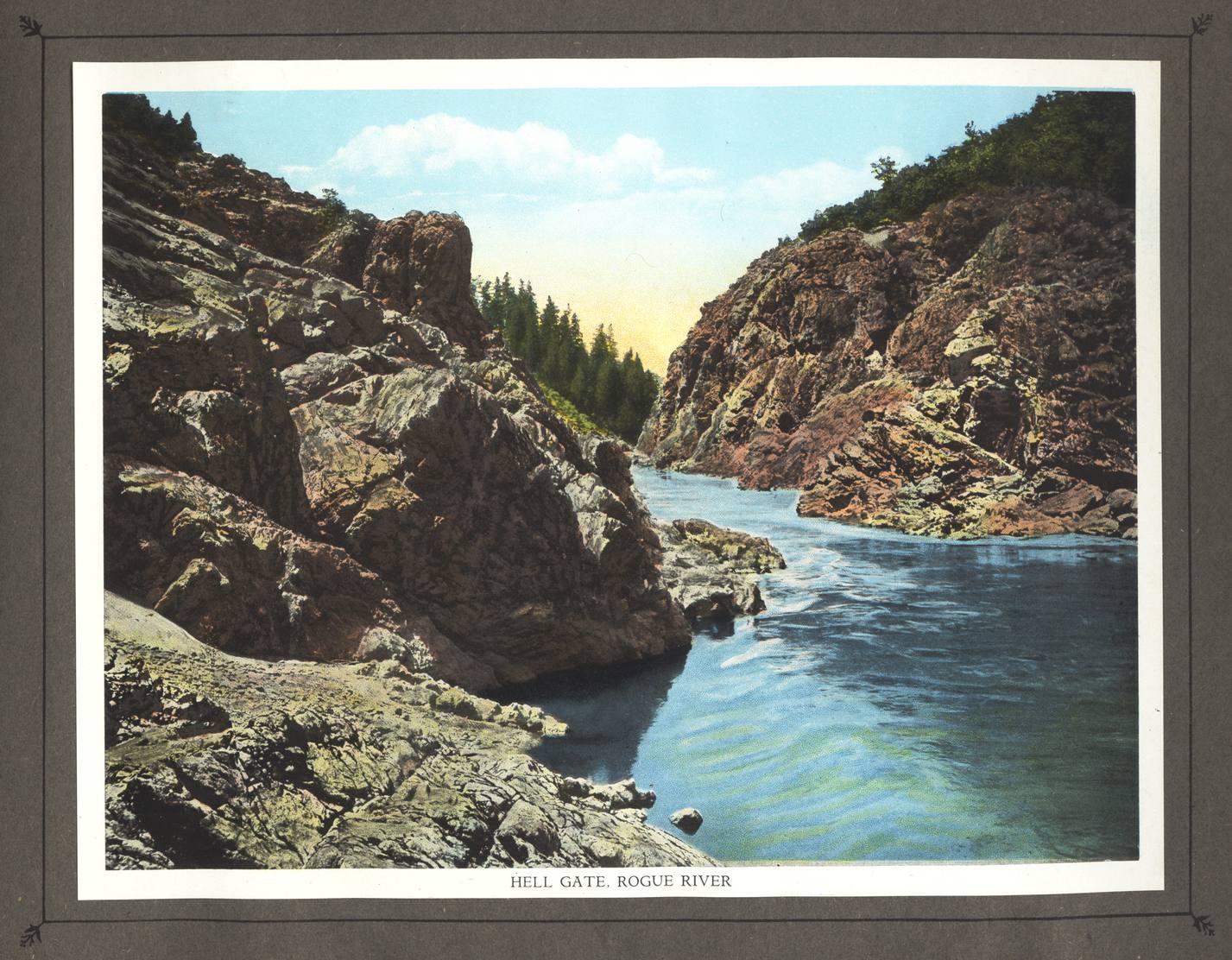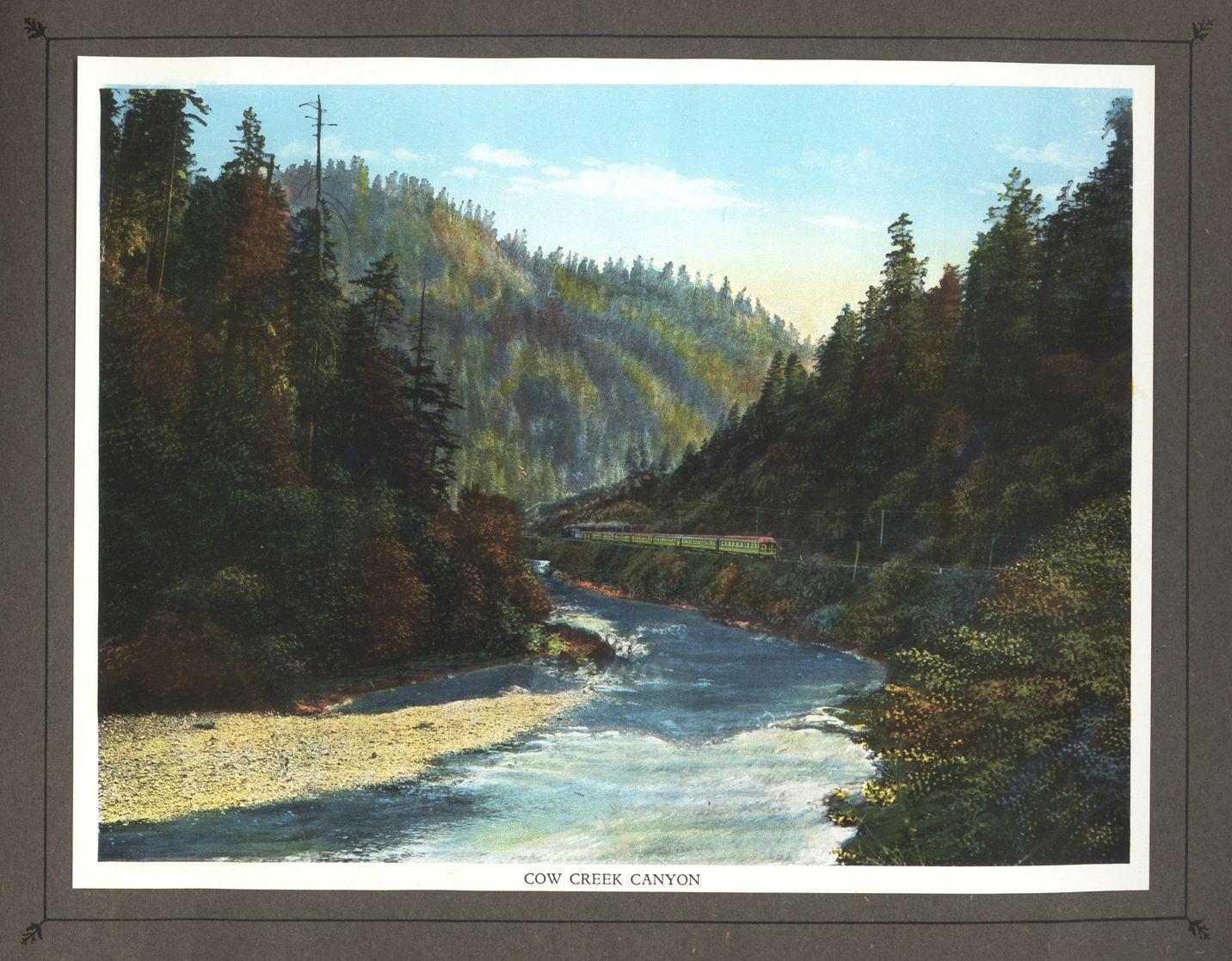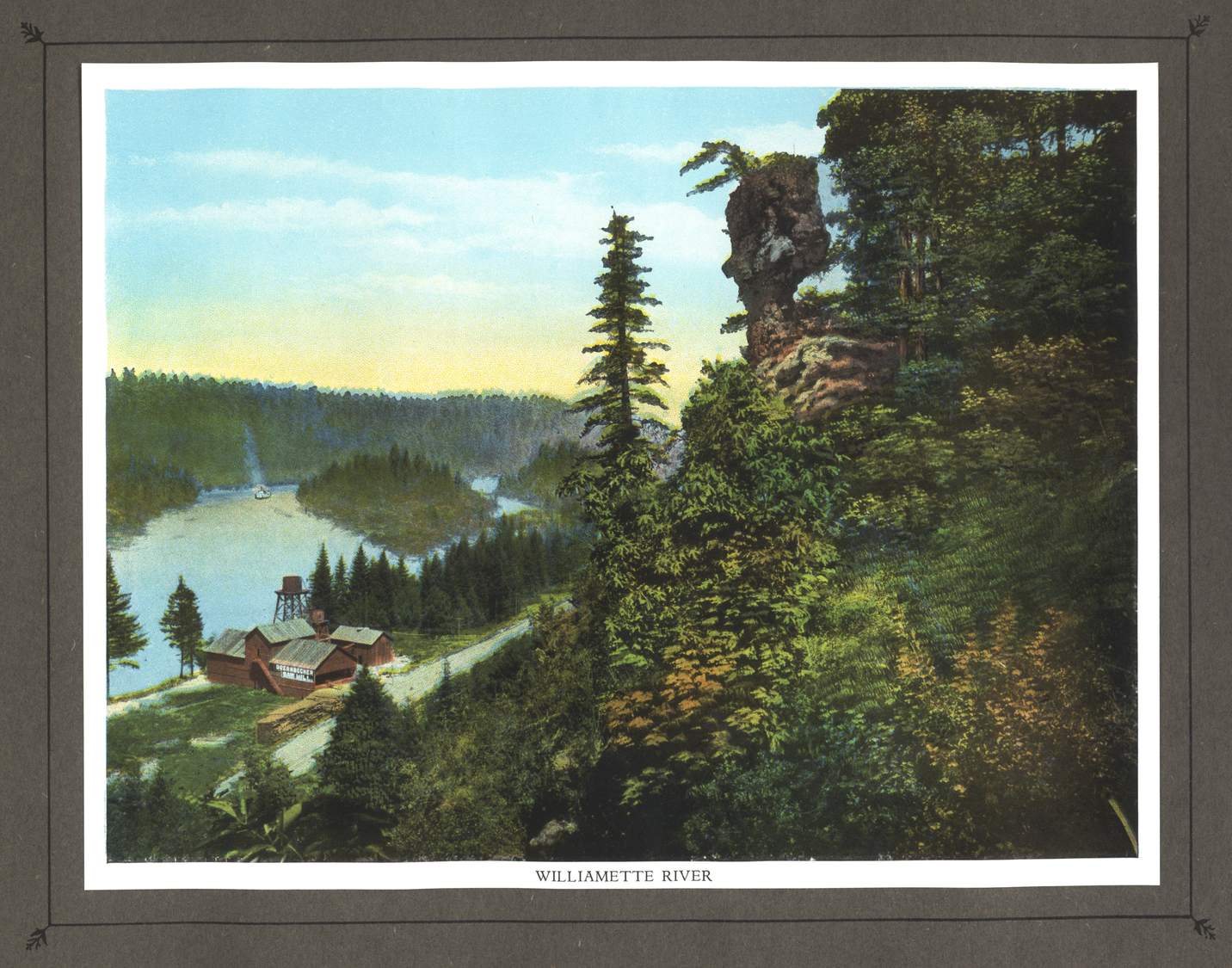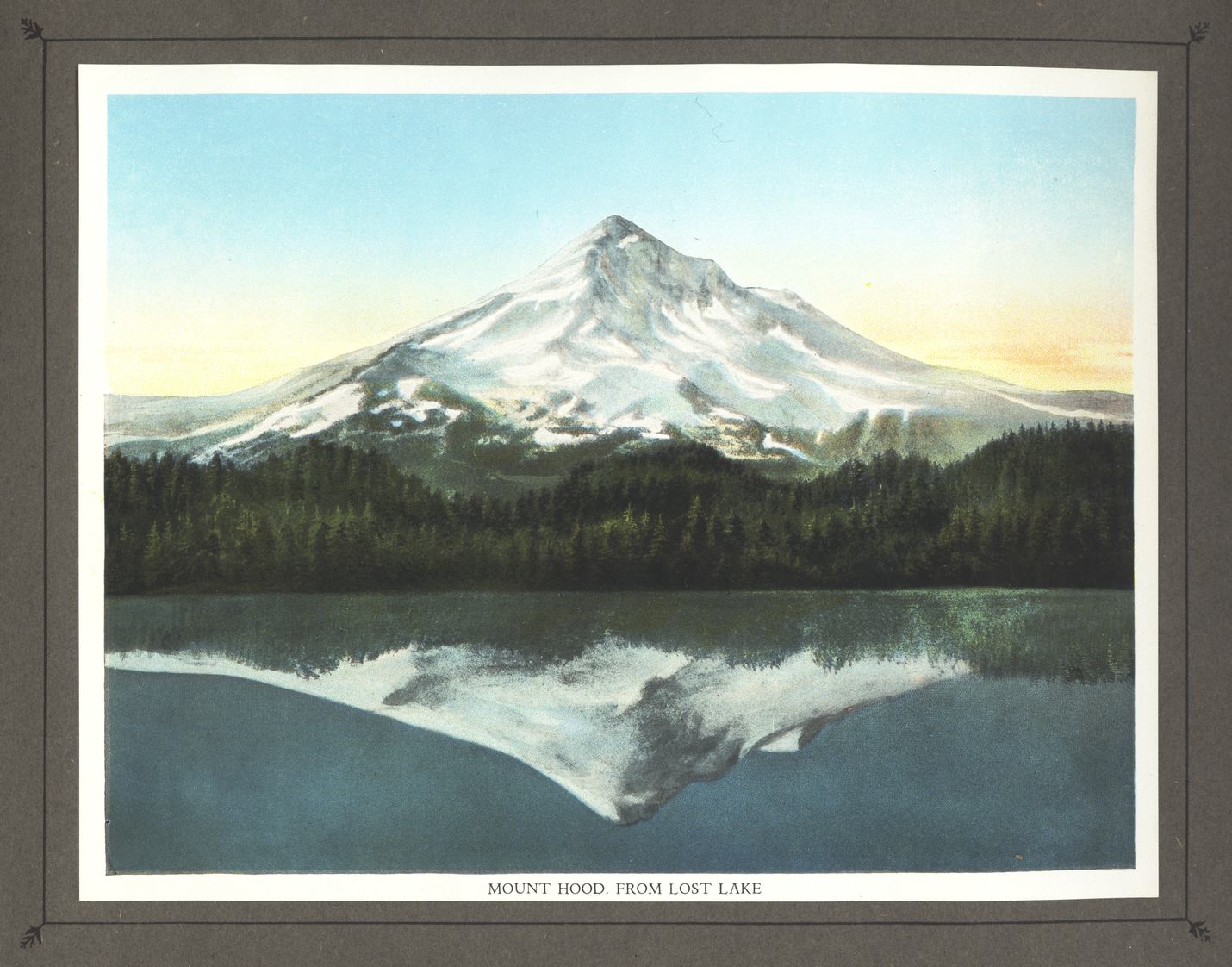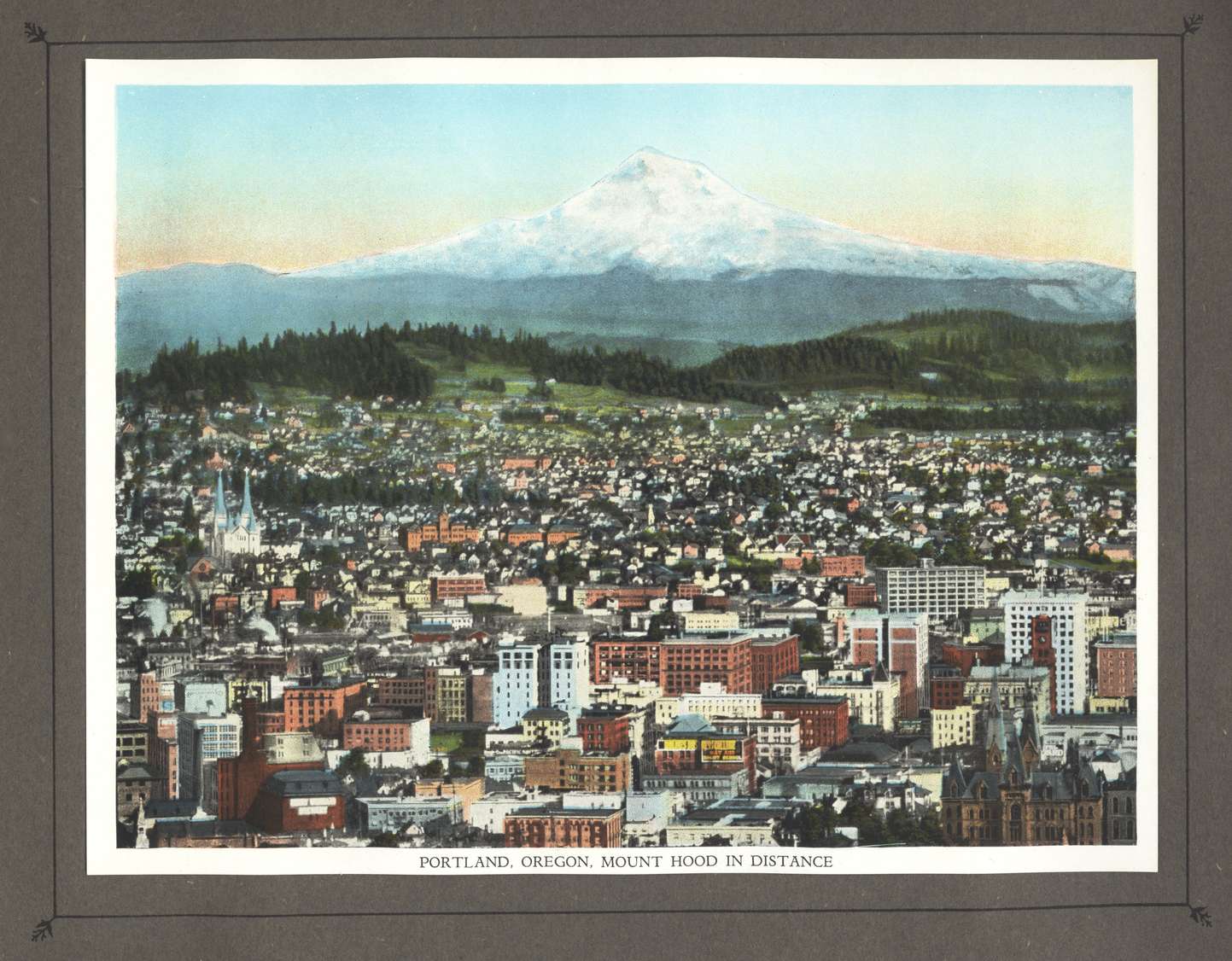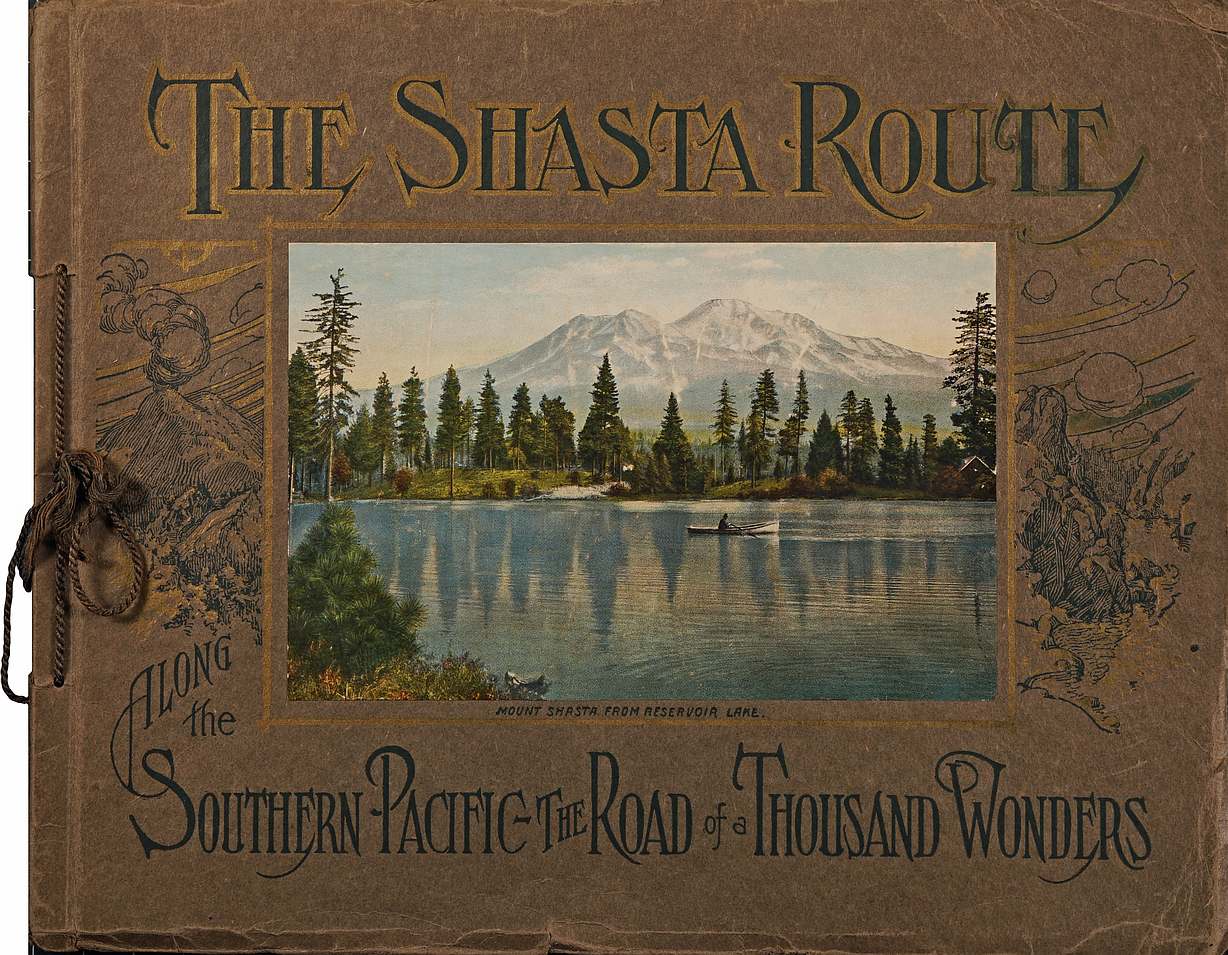
MOUNT SHASTA FROM RESERVOIR LAKE.
The Shasta Route
ALONG the
Southern Pacific—the Road of a Thousand Wonders
Title: The Shasta route in all of its grandeur
Creator: Southern Pacific Company
Release date: July 11, 2022 [eBook #68494]
Most recently updated: October 18, 2024
Language: English
Original publication: United States: Curt Teich & Co, 1920
Credits: Juliet Sutherland, Charlie Howard, The Internet Archive, and the Online Distributed Proofreading Team at https://www.pgdp.net
Transcriber’s Notes:
Larger versions of the illustrations may be seen by right-clicking them and selecting an option to view them separately, or by double-tapping and/or stretching them. High-resolution versions of the illustrations may be seen by clicking High-Resolution below them.
The Table of Contents for this picture book is its “Explanation of Views Illustrated”. The headings link to the illustrations.

MOUNT SHASTA FROM RESERVOIR LAKE.
ALONG the
Southern Pacific—the Road of a Thousand Wonders
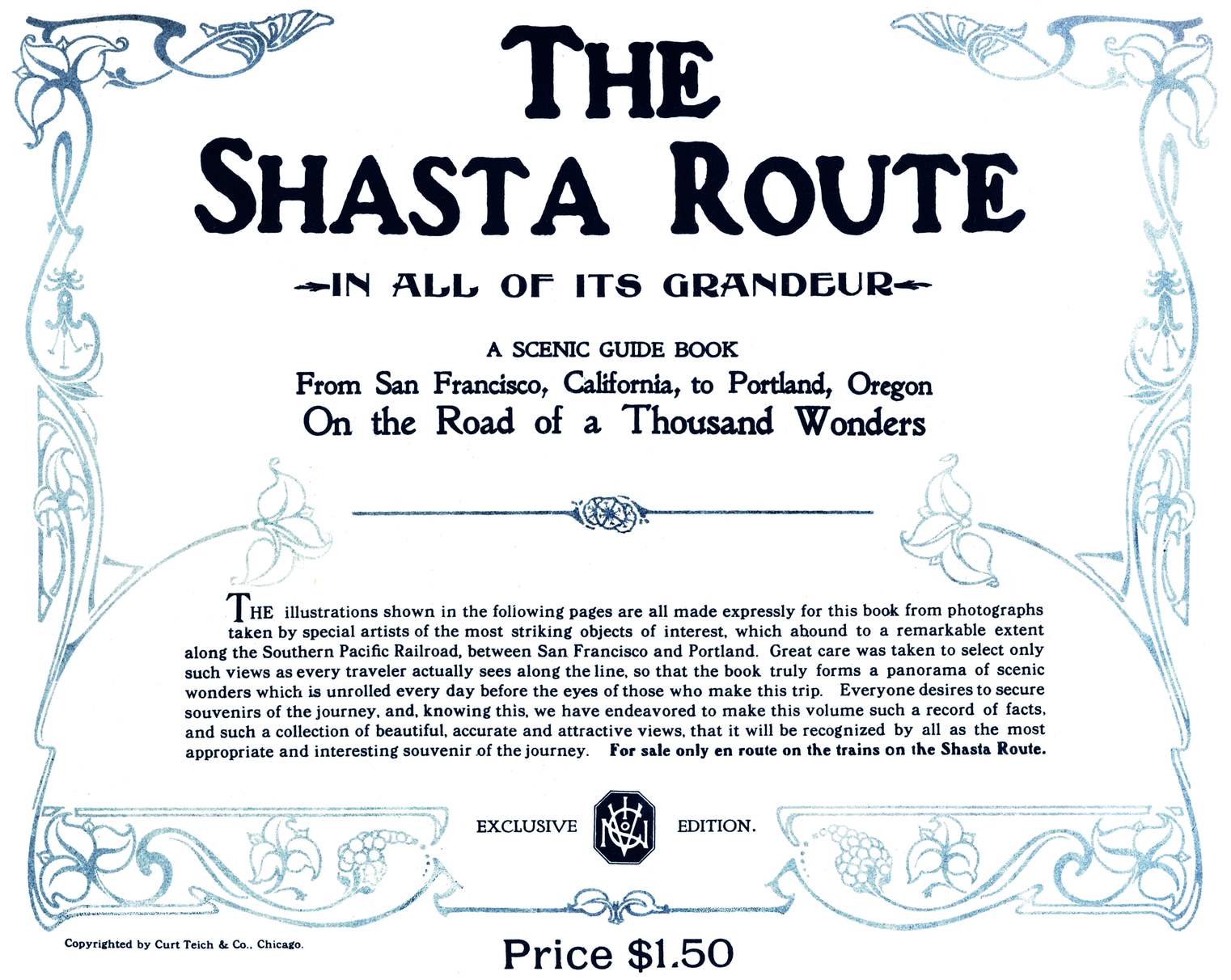
The
Shasta Route
→IN ALL OF ITS GRANDEUR←
A SCENIC GUIDE BOOK
From San Francisco, California, to Portland, Oregon
On the Road of a Thousand Wonders
The illustrations shown in the following pages are all made expressly for this book from photographs taken by special artists of the most striking objects of interest, which abound to a remarkable extent along the Southern Pacific Railroad, between San Francisco and Portland. Great care was taken to select only such views as every traveler actually sees along the line, so that the book truly forms a panorama of scenic wonders which is unrolled every day before the eyes of those who make this trip. Everyone desires to secure souvenirs of the journey, and, knowing this, we have endeavored to make this volume such a record of facts, and such a collection of beautiful, accurate and attractive views, that it will be recognized by all as the most appropriate and interesting souvenir of the journey. For sale only en route on the trains on the Shasta Route.
EXCLUSIVE EDITION.
Copyrighted by Curt Teich & Co., Chicago.
Price $1.50
The charm of a trip along the Shasta Route of the Southern Pacific, often termed “The Road of a Thousand Wonders,” is recognized by the traveled world. It offers a succession of grandeur and scenic beauty unexcelled by any railroad trip in America.
This is one of the most famous views of this imperial mountain peak.
From the Ferry Building, at the foot of Market Street, the ferry boats of the Southern Pacific take the traveler across San Francisco Bay to Oakland Pier. The Ferry Building, erected in 1896 at a cost of $1,000,000, is the water gate of San Francisco, where rail and tide meet. There is scarcely a minute in the day when there is not a ferry either arriving at or departing from some one of the ferry slips.
San Francisco, the starting point of this journey, is the largest and best known of the cities on the Pacific Coast. This bird’s eye view of lower San Francisco, the Ferry Building and San Francisco Bay, shows the splendid body of water facing the city. This Bay is seventy miles long and from three to ten miles wide, and has an area of four hundred and fifty square miles. Vessels of all descriptions, and from all parts of the globe, populate San Francisco harbor, which is the pride and marvel of all navigators. Yerba Buena Island is seen on the left, the trans-bay cities of Oakland, Berkeley and Alameda, and ferryboat landings in the middle distance, while in the distance is seen Mount Diablo.
Oakland, the third largest city in California is but eighteen minutes from San Francisco via the Southern Pacific’s fine transbay steamers.
With its fine harbor facilities, Oakland is rapidly growing as a commercial center, carrying on an extensive coastwise and foreign trade. Its position on the east side of the bay, makes it a great railroad terminal for all lines from the north, south and east.
As a community of homes, Oakland has a well deserved fame, for its setting is picturesque and the climate nears perfection.
Oakland has many attractive parks and public playgrounds. Lake Merritt, near the Civic Center is a natural water-park, and state game reserve, where thousands of wild ducks make their winter home, an unusual sight, indeed. Boating may be enjoyed every day in the year.
Oakland’s City Hall, with its massive tower, is the tallest building in California, its height being 377 feet.
This ferry carries Southern Pacific trains and passengers between Port Costa and Benicia, crossing the Carquinez Straits. The distance is about a mile and requires about twenty minutes. The ferry was constructed as a sister ship to the ferry “Solano” and is the largest ferry in the world. It is 433 feet long, cost $450,000, and has a capacity of 36 cars and two engines.
Lassen Peak, California, is the latest scene of volcanic activity on the Pacific Coast, adding another point of interest along “The Road of a Thousand Wonders.” Lassen Peak with its elevation of 10,577 feet, can be seen from the car windows of the “Shasta Route” trains, and can be visited from Red Bluff or Redding by automobile.
This is one of the finest views in the canyon, with the mighty form of Mt. Shasta in the background. The great white cap extends 14,444 feet above the sea. The foothill counties tributary to this valley are rich in gold and other minerals, while the rich soil of the entire valley is adapted to raising of a most diverse variety of crops. The upper canyon of the Sacramento River constantly presents to the traveler an ever-changing scene of astounding splendor.
Castle Crags, in the Sacramento Canyon, are great granite rocks, rising close beside the track, to a height of 4,000 feet. Their vertical strata splintered into a hundred parapets, makes this a scene never to be forgotten. Beyond the Crags is Castle Lake at an elevation of 7,245 feet, and from this point appears the rounded summit of Mt. Shasta, silver against the turquoise sky; a watch tower of the world, gazing ever toward the eternal.
Here one of the enormous streams which have their origin in the melting snows of Mt. Shasta, divides itself into a myriad of little waterways before reaching the top of a wooded semi-circular cliff, from which point it tumbles into the Sacramento River, a hundred feet below, forming Mossbrae Falls, as they appear like a thousand springs born under the rocky ground.
Shasta Springs, near the base of Mount Shasta, is one of the best-known all-the-year-around resorts in the world. Here the train stops long enough for a drink of the famous sparkling Shasta water, real soda water. This resort is noted for its scenic beauty and its health-giving water.
The train spends five hours crossing and recrossing the Sacramento River. This loop was devised to get out of the canyon and up on the plateau where stands Mt. Shasta, with its snowy summit, as seen from the car windows; nothing could be a more glorious tribute to the marvelous skill of the modern railroad engineer, than the obstacles met with and overcome in building a railroad through this rugged country.
At this point the traveler finds himself at the base of the mountain, and if he desires, can arrange a genuine Alpine mountain climbing trip. The town stands at the base of the mountain and a road runs to the edge of the timber line, which has made possible an ascent of the mountain in a single day. The wonderful view from the summit, 14,444 feet above the sea, is bounded only by the curvature of the world’s disc, and there is not a finer view to be had anywhere.
There are numerous volcanic cones scattered throughout this part of California. One of the best-known is Black Butte, also called Muirs Peak. Its cone is almost perpendicular to a height of almost 6,000 feet, close to the base of Mt. Shasta—black, bare and desolate, an extinct volcano, with half a dozen craters in plain view. Mt. Shasta is an extinct volcano, one of the highest peaks on the North American Continent. Its snows and glaciers feed hundreds of streams which thread the wild region in every direction. These wild regions are a paradise for the sportsman and lover of nature. Grizzly, black and cinnamon bear abound, elk, deer and mountain sheep are plenty, as well as a great variety of smaller game. The streams are alive with trout.
Here is one of the favorite view points of this great snow-capped mountain and where the majestic grandeur of the mountain is most apparent. Edgewood, as the name suggests, is literally the edge of the forest. From this point to the summit of the Siskiyous there is very little timber.
The Klamath Country has no superior as a pleasure realm for the sportsman and camper, and of unusual interest to tourists. Much of this region is still a wilderness, full of the charm of mountain and forest. Its marches are breeding grounds for wild fowl; its clear streams and broad lakes are full of lusty, hard-fighting trout, and in its forests roam deer, bear and cougars. Mount McLoughlin, the highest peak in southern Oregon, is 9,760 feet above sea level.
Crater Lake lies in the heart of the Cascade Range, in southern Oregon, its surface 6,177 feet above sea level. As its name suggests, it is the crater of an extinct volcano. Crater Lake has been sounded to a depth of 1,996 feet and declared by scientists to be the deepest inland body of water in the world. Rising almost sheer from the water’s edge, the rim of the lava cliffs attain at places a height of 2,000 feet. From Crater Lake Lodge, on the rim of the lake, the opposite shore is six miles away. Wizard Island is a perfectly preserved cinder cone rising nearly 1,000 feet above the lake. You may climb the slaggy timbered cone of Wizard Island and descend one hundred feet into its crater which is five hundred feet across.
This picture represents one of the difficulties of railroads through this rugged mountain range and shows elevation is overcome by the use of tunnels. A tunnel is cut through the rocks; a circuit is made leading back to the same point at a higher elevation and another tunnel is cut directly over the first one. The traveler will find this a most interesting view as the train winds its way through these mountains.
Table Rock is familiar in Indian history as the place where Captain Jack of the Modoc Indians made his last stand; was captured and hung at Old Fort Klamath, ending the historical Modoc war. Snow-capped Mt. Pitt, rising to an altitude of 9,760 feet, is visible from this point.
This picture shows the character of the upper stretches of this splendid trout stream. Anglers cross the continent for the joys of fishing this stream. The line of the Shasta Route from Medford to Crater Lake follows this canyon and affords many beautiful views.
Despite its unromantic title, this canyon has few rivals in the attractiveness of its scenery. For a long way, the tracks run parallel to the stream, which races in rapid rivalry with the train. Its rugged walls on every hand form grotesque outlines, suggesting weird figures to the imagination of a nature-loving mind.
The Southern Pacific “Shasta Route” follows for 150 miles, the beautiful Williamette River, and from the car windows, may be glimpsed views of its wooded banks, its gleaming reaches and winding course that will delight the beholder. The Williamette Valley through which it flows is the principal valley of Western Oregon.
This mountain is often spoken of as the “Pride of Oregon.” Its uppermost peak reaches an altitude of 11,225 feet and is plainly visible from many points on this part of “The Road of a Thousand Wonders.” While this grand mountain is easy to climb, the ascent is steep and the alpenstock and rope are used to aid one in his upward journey. On the top one finds a region of perpetual snow, but the view is indescribably grand. The trip to the summit is one of the most popular trips out of Portland.
Portland, often termed the “Rose City,” has many natural advantages and points of interest to the traveler. This popular name is derived from the city’s beautiful parks and homes, where roses are in abundance everywhere. A trip up the Columbia River from Portland will leave an impression on the traveler never to be forgotten. Mountain climbing and ocean bathing are popular sports that help to make Portland a favorite stopping point.
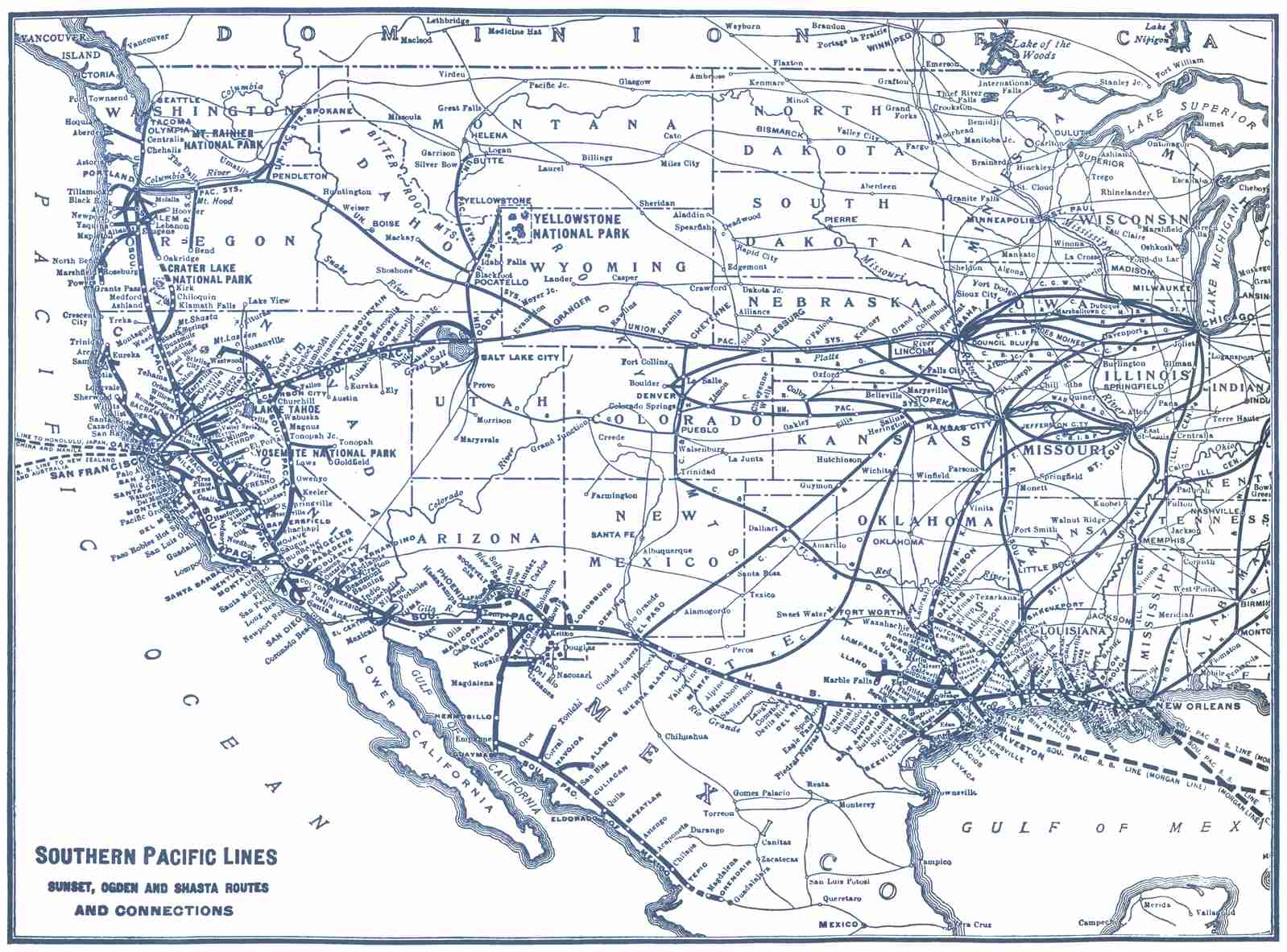
Southern Pacific Lines
SUNSET, OGDEN AND SHASTA ROUTES
AND CONNECTIONS
